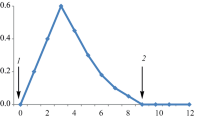Summary
Expression of the galactokinase gene in Tetrahymena thermophila can be repressed by glucose, glucose analogs, and epinephrine, each apparently acting through increased intracellular levels of adenosine 3′:5′-cyc lic monophosphate (cAMP) (1). To characterize further the initial steps in the control of galactokinase gene-expression by glucose, we have analyzed mutants which are defective in the metabolism of this sugar; these mutants were selected for their resistance to the glucose analog, 2-deoxyglucose (2). In one such mutant that is deficient in glucokinase, the synthesis of galactokinase is totally resistant to repression by glucose or its analogs, while repression by exogenous catecholamines or dibutyryl cAMP is unaffected. Radiochromatographic analyses of extracts of wild-type cells incubated with [14C]-deoxyglucose reveal intracellular conversio to several deoxyglucose metabolites, principally deoxyglucose-6-P and smaller amounts of deoxyglunose 1-P and 2-deoxygluconate; extracts of glucokinase-deficient cells prepared in a similar manner contain only trace amounts of deoxyglucose-6-P. The glucose analog 3-O-methylglucose, which is transported but not phosphorylated in wild-type cells, also cannot maintain repression of galactokinase. These results establish that the transport and subsequent phosphorylation of glucose are required for glucose-initiated repression of galactokinase gene expression, possibly acting by modulation of catecholamine or cyclic AMP levels.
Additionally, we show unequivocally that: (a) cells containing derepressed levels of galactokinase are repressed upon the addition of glucose by inhibition of the synthesis of new enzyme and dilution of preformed enzyme concomitant with cell division, rather than through selective inactivation or degradation of galactokinase; and (b) glycerol kinase, glucokinase and fructokinase activities also are repressed by glucose in wild-type Tetrahymena, indicating that the glucose repression phenomenon is pleiotropic. Because the glucose repression of the synthesis of each of these enzymes is abolished in cells deficient in glucokinase, the regulatory mechanisms elucidated for repression of galactokinase synthesis are likely to be of wide significance.
Similar content being viewed by others
References
Roberts, C. T., Jr. & Morse, D. E., 1978. Proc. Natl. Acad. Sci. 75: 1810–1814.
Roberts, C. T., Jr., Lavine, J. E. & Morse, D. E., 1982. Molec. Cell. Biol. 2: 378–385.
Miller, Z., Varmus, H. E., Parks, J. S., Perlman, R. L. & Pastan, I., 1971. J. Biol. Chem. 246: 2898–2903.
Douglas, H. C. & Hawthorne, D. C., 1966. Genetics 54: 911–916.
Tao, M. & Schweiger, M., 1970. J. Bacteriol. 102: 138–141.
Magasanik, B., 1961. Cold Spring Harbor Symp. Quant. Biol. 26: 249–256.
Pastan, I. & Adhya, S., 1976. Bact. Rev. 40: 527–551.
Sy, J. & Richter, D., 1972. Biochemistry 11, 2788–2791.
Van Wijk, R. & Konijn, T. M., 1971. FEBS Lett. 13: 184.
Schlander, G. & Dellweg, H., 1974. Eur. J. Biochem. 49: 305–316.
Nandini-Kishore, S. G. & Thompson, G. A. Jr., 1979. Proc. Natl. Acad. Sci. 76: 2708–2711.
Ramanathan, S. & Chou, S. C., 1973. Experientia 29: 814.
Janakidevi, K., Dewey, V. C. & Kidder, G. W., 1966. J. Biol. Chem. 241: 2576–2578.
Rozensweig, Z. & Kindler, S. H., 1972. FEBS Lett. 25: 221–223.
Kassis, S. & Kindler, S., 1975. Biochim. Biophys. Acta 391: 513–516.
Holzer, H., 1976. Trends Biochem. Sci. 1: 178–181.
Matern, H. & Holzer, H., 1977. J. Biol. Chem. 252: 6399–6402.
Entian, K. D., 1977. Mol. Gen. Genet. 158: 201–210.
Nanney, D. L. & McCoy, J. W., 1976. Trans. Amer. Micro. Sec. 95: 664–682.
Roberts, C. T., Jr. & Morse, D. E., 1980. Mol. Gen. Genet. 180:129–134.
Thorner, J. W., 1975. In: Methods in Enzymology (Wood, W.A., ed.) Vol. 42, pp. 148–156, Academic Press, New York.
Bradford, M., 1976. Anal. Biochem. 72: 248–254.
Dryl, S., 1959. J. Protozool. 6 (Suppl.), 25.
Hanes, C. S. & Isherwood, F. A., 1949. Nature 164: 1107–1109.
Fischer, W. & Weidemann, G., 1964. Hoppe-Seyler's Z. Physiol. Chem. 336: 206–218.
Aomine, M., 1976. Comp. Biochem. Physiol. 55A: 159–163.
Lavine, J. E., Cantlay, E., Roberts, C. T., Jr. & Morse, D. E., 1982. Biochim. Biophys. Acta. (In press.)
Smith, D. F. & Keppler, D. O. R., 1977. Eur. J. Biochem. 73: 83–92.
Schmidt, M. F. G., Schwarz, R. T. & Scholtissek, C., 1974. Eur. J. Biochem. 49: 237–247.
Kipnis, D. M. & Cori, C. F., 1959. J. Biol. Chem. 234: 171–177.
Brooks, S. A., Lawrence, J. C. & Ricketts, C.R., 1960. Nature 187: 1028–1029.
Plagemann, P. G. W., 1973. J. Cell Physiol. 82: 421–433.
Hatanaka, M. & Hanafusa, H., 1970. Virology 41: 647–652.
Biely, P. & Bauer, S., 1968. Biochim. Biophys. Acta 156: 432–434.
Kaluza, G., Schmidt, M. F. G. & Scholtissek, C., 1973. Virology 54: 179–189.
Peterkofsky, A. & Gazdar, C., 1975. Proc. Natl. Acad. Sci. 72:2920–2924.
Makman, R. S. & Sutherland, E. Q., 1965. J. Biol. Chem. 240:1309–1314.
Kundig, W., Ghosh, S. & Roseman, S., 1964. Proc. Natl. Acad. Sci. 52: 1067–1074.
Sanford, Y. M. & Orias, E., 1981. Proc. Natl. Acad. Sci. 78: 7614–7619.
Author information
Authors and Affiliations
Rights and permissions
About this article
Cite this article
Lavine, J.E., Roberts, C.T. & Morse, D.E. Glucose regulation of specific gene expression is altered in a glucokinase-deficient mutant of Tetrahymena . Mol Cell Biochem 48, 45–58 (1991). https://doi.org/10.1007/BF00214821
Received:
Issue Date:
DOI: https://doi.org/10.1007/BF00214821



